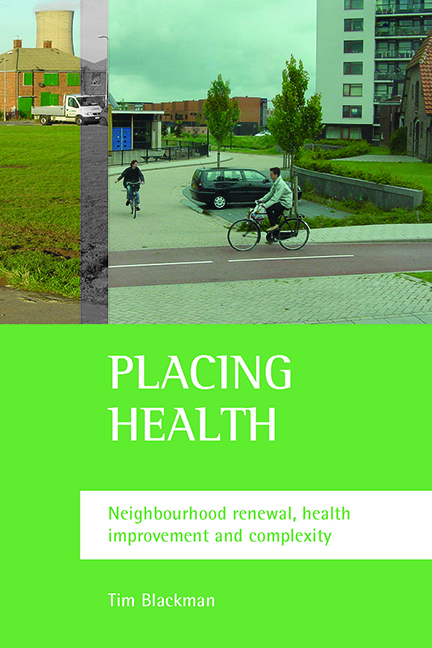Book contents
- Frontmatter
- Dedication
- Contents
- List of tables and figures
- Acknowledgements
- List of abbreviations
- Preface
- one Policy and places
- two Health, neighbourhoods and complexity
- three Emergence and environment press
- four The neighbourhood effect
- five Neighbourhood renewal and health inequalities
- six Health inequality as a policy priority
- seven Conclusion: neighbourhoods in the wider picture
- References
- Index
- Also available from The Policy Press
seven - Conclusion: neighbourhoods in the wider picture
Published online by Cambridge University Press: 18 January 2022
- Frontmatter
- Dedication
- Contents
- List of tables and figures
- Acknowledgements
- List of abbreviations
- Preface
- one Policy and places
- two Health, neighbourhoods and complexity
- three Emergence and environment press
- four The neighbourhood effect
- five Neighbourhood renewal and health inequalities
- six Health inequality as a policy priority
- seven Conclusion: neighbourhoods in the wider picture
- References
- Index
- Also available from The Policy Press
Summary
Layard (2005), in what I believe is an important book, maps out the ‘new science’ of happiness, a state associated with, but not the same as, good health. Ultimately, policies for neighbourhoods should be aiming at happy neighbourhoods as well as healthy ones. Step outside the front door and there are things to be happy about rather than things that are troubling or stressful. These may be a job to go to; a place for children to play and teenagers to hang out; neighbours that we trust and spend some time with; contact with nature and trees; an environment that is looked after, reflects well on us and is free from hazards; shops and services that are reachable; participation in decisions that affect us and our neighbourhood; and, above all, a place that we want to be. This does not mean that the neighbourhood necessarily makes a great difference for many of us, but that the more it constrains, stresses or disables us the more likely it is that our health will be damaged. Neighbourhoods, therefore, are a legitimate object of policy. They are systems that among their many inputs may sometimes need policy interventions.
Amin (2002) suggests that we think of places as nodes in networks of relationships that situate practices in space. I have gone further than this to argue that residential places are systems. Amin argues that practices may or may not reinforce local connections so that the place itself has agency. He plays down any idea that places have a special agency in themselves. As nodes of situated practices they are less obviously agents than firms, governments, social movements or other types of organisation. Practices in a place will often have much more significant relationships with networks beyond that place than with the place itself, so ‘places are more than what they contain, and what happens in them is more than the sum of localised practices and powers, and actions at other ‘spatial scales’’ (Amin, 2002, p 395). However, Amin does not deny the significance of proximity and particularity in space, both because levels of government are organised territorially, and because these characteristics engender political and social movements and local action of various kinds. But he reminds us that this action, although situated locally, engages with relational networks beyond any single place.
- Type
- Chapter
- Information
- Placing HealthNeighbourhood Renewal, Health Improvement and Complexity, pp. 177 - 202Publisher: Bristol University PressPrint publication year: 2006



